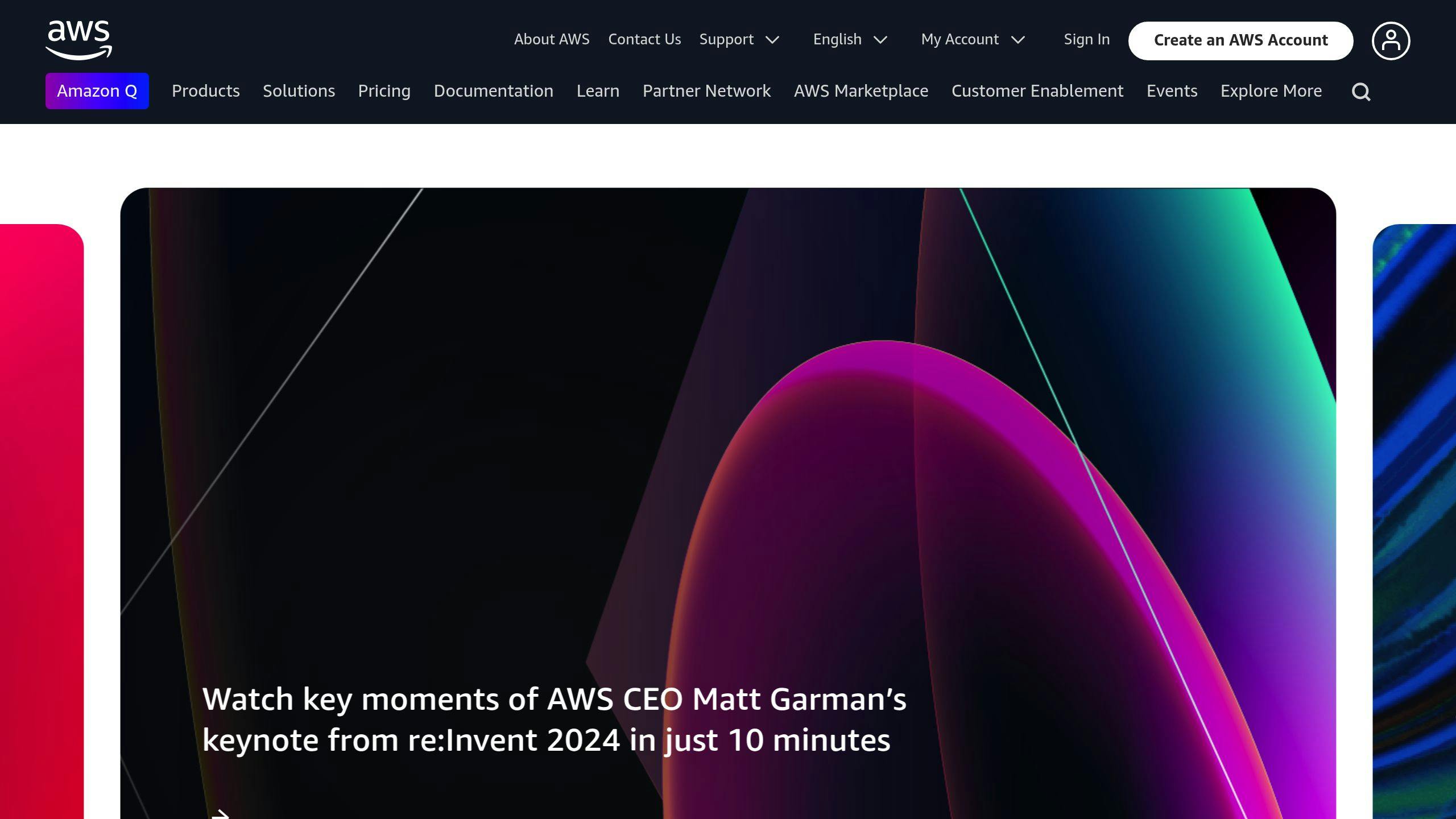AWS network performance directly impacts application reliability, scalability, and user experience. Here's what you need to know:
- Core Metrics: Focus on throughput, latency, jitter, and packet loss to evaluate performance.
- AWS Tools: Use CloudWatch, VPC Flow Logs, and external tools like iperf for monitoring and testing.
- Setup Essentials: Design a VPC with proper subnets, choose EC2 instances with Enhanced Networking, and configure network features like Elastic Network Adapter (ENA) and SR-IOV.
- Optimization Tips: Use jumbo frames (MTU 9001), fine-tune TCP settings, and consider AWS Direct Connect for high-speed, low-latency connections.
Quick Comparison of Tools and Features
| Feature/Tool | Purpose | Key Benefit |
|---|---|---|
| CloudWatch | Real-time monitoring | Tracks throughput, latency, and errors |
| iperf | Throughput testing | Measures bandwidth and packet loss |
| Direct Connect | Dedicated connection to AWS | Reduces latency and packet loss |
| Transit Gateway | Multi-VPC routing | Simplifies complex network architectures |
Start by setting up a robust test environment, monitor your metrics, and adjust configurations to ensure optimal AWS network performance.
Network Performance Testing Tools
AWS offers several tools for monitoring network performance, with built-in options complemented by external tools for more detailed analysis.
Built-in AWS Monitoring Tools

AWS provides tools like CloudWatch and VPC Flow Logs to help you monitor and analyze network performance. These tools offer real-time data and traffic insights, making it easier to spot issues like bottlenecks or anomalies.
| Tool | Function | Key Metrics |
|---|---|---|
| CloudWatch | Real-time monitoring | Throughput, latency, packet loss |
| VPC Flow Logs | Traffic analysis | IP traffic patterns, security insights |
| CloudWatch Logs Insights | Log data analysis | Trends and anomalies |
External Testing Tools
For more in-depth testing, external tools such as iperf and netperf can be used alongside AWS's built-in features. These tools are particularly helpful for protocol-specific performance testing, especially in hybrid or multi-region setups.
- iperf: Measures bandwidth using TCP/UDP protocols, with options for configurable test durations and parallel streams.
- netperf: Focuses on latency, bandwidth, and CPU usage, offering multiple testing modes.
EC2 Network Metrics
The Elastic Network Adapter (ENA) provides detailed metrics to help you assess and optimize EC2 network performance. These metrics are essential for benchmarking and fine-tuning your setup.
| Metric Category | Key Measurements |
|---|---|
| Bandwidth | Maximum throughput, current utilization |
| Connection and Queue Metrics | Active connections, errors, queue depth, overflow events |
To ensure accurate test results, make sure your EC2 instances are located in the same Availability Zone.
"The ENA driver provides detailed network performance metrics, including throughput and latency measurements, which can be used to optimize EC2 instance network performance. By monitoring these metrics, users can identify bottlenecks and adjust instance configurations or network settings to improve performance."
AWS Test Environment Setup
Setting up an AWS test environment correctly is key for reliable benchmarking results.
Network Infrastructure Setup
Start by configuring a Virtual Private Cloud (VPC) with subnets spread across multiple Availability Zones (AZs). This setup enables thorough performance testing.
| Component | Configuration | Purpose |
|---|---|---|
| VPC | One per region | Supports isolated and cross-AZ testing |
| Subnets | One per AZ | Facilitates testing across AZs |
| Security Groups | Allow test traffic | Ensures benchmarking traffic is permitted |
Make sure to configure both IPv4 and IPv6 network stacks. Additionally, set up route tables and Network ACLs to carefully manage traffic flow without compromising test accuracy.
After the network infrastructure is ready, choosing the right EC2 instances becomes the next crucial step.
EC2 Instance Selection
Pick EC2 instances that align with your network performance needs. Instances with Enhanced Networking support deliver better performance for benchmarking tasks.
| Instance Feature | Requirement | Impact |
|---|---|---|
| ENA Support | Required | Enables higher throughput and lower latency |
| Network Bandwidth | Up to 100 Gbps | Depends on the selected instance type |
| Placement Group | Cluster | Reduces latency between instances |
For Linux systems, ensure your instances support the Elastic Network Adapter (ENA) driver version 2.2.10 or newer to unlock advanced networking capabilities [1][2].
Network Feature Configuration
-
Elastic Network Adapter (ENA)
Confirm driver compatibility and adjust network settings to maximize performance for high-throughput workloads. -
Single Root I/O Virtualization (SR-IOV)
Enable SR-IOV in your VPC settings to reduce latency and improve packet processing efficiency [2]. -
Network Monitoring
Use tools like CloudWatch to monitor network performance in real time during benchmarking. This helps ensure your results are accurate and reliable.
Running Network Tests
Testing your network setup in AWS helps confirm its configuration and assess performance under practical conditions.
Throughput Testing
To measure TCP and UDP throughput, iperf3 is a reliable tool. It tracks metrics like bandwidth, retransmits, packet loss, and jitter. Configure one instance as the server and another as the client to test bi-directional throughput. For reliable data, run tests multiple times at different times of the day and calculate the average results.
Latency and Jitter Testing
Latency testing assesses round-trip time (RTT), packet loss, and jitter, giving insight into network responsiveness. For basic checks, use ping, or opt for advanced tools for a more detailed analysis. If your application demands high reliability, run long-duration tests to account for traffic fluctuations.
Multi-Region Performance Testing
Testing across AWS regions helps you understand performance variations between them. Use cross-region VPC peering for inter-region tests while keeping an eye on transfer costs. Tools like AWS Global Accelerator can enhance edge location performance, and Direct Connect ensures steady bandwidth for hybrid environments.
To automate these tests, consider integrating network performance checks into your CI/CD pipeline using AWS CodePipeline. This approach allows for continuous monitoring as your infrastructure changes.
sbb-itb-6210c22
Network Performance Improvement
Improving AWS network performance involves fine-tuning configurations and using specialized services. Here's a breakdown of key strategies to boost your network's efficiency.
EC2 Network Settings
Start by configuring your EC2 instances for optimal network performance. Use an MTU of 9001 bytes to enable jumbo frames, which are ideal for high-throughput data transfers. Fine-tune your TCP settings by:
- Setting a 64KB window size
- Enabling TCP Fast Open to reduce connection latency
- Adjusting buffer sizes to match your workload needs
"Common pitfalls include misconfiguring TCP parameters and MTU sizes, which can lead to decreased performance. These can be mitigated by carefully testing and validating network settings before deploying them in production environments" [1].
After optimizing EC2 settings, consider using AWS Direct Connect for dedicated and faster network connectivity.
Direct Connect Implementation
AWS Direct Connect offers a private, high-speed connection between your on-premises setup and AWS. It supports a range of bandwidth options, depending on your needs:
| Bandwidth Options | Connection Type |
|---|---|
| 50-500 Mbps | Hosted |
| 1-10 Gbps | Hosted |
| Up to 100 Gbps | Dedicated |
For businesses requiring higher bandwidth and redundancy, Direct Connect supports link aggregation groups (LAGs). This makes it a great choice for hybrid architectures that demand reliable, high-bandwidth connections.
While Direct Connect strengthens on-premises and AWS connectivity, advanced routing techniques can enhance performance across more complex setups, such as global or multi-VPC environments.
Advanced Network Routing
For applications that span multiple regions or VPCs, advanced routing ensures smooth traffic flow and consistent performance. AWS Network Manager helps identify bottlenecks and optimize routing paths [4].
Key tools for advanced routing include:
- Transit Gateway: Simplifies routing across multiple VPCs and on-premises networks
- Global Accelerator: Improves performance by using edge locations and offers static IP addresses for consistency
Use AWS CloudWatch to track critical metrics and confirm performance gains, such as:
- Network throughput
- Latency changes
- Packet loss rates
- CPU usage impacts
Conclusion
Best Practices Summary
To achieve reliable AWS network performance benchmarking, it's essential to follow a structured approach that integrates effective tools and tested methods. Here are some key strategies:
- Monitor your network infrastructure thoroughly to identify and address potential bottlenecks.
- Utilize centralized architectures with ECMP routing to maximize bandwidth usage.
- Automate routine performance checks through CI/CD pipelines to ensure consistency.
- Fine-tune network settings based on specific workload requirements.
These steps create a strong foundation for dependable and high-performing AWS networks.
Additional Resources
Looking for more guidance? Check out AWS for Engineers (https://awsforengineers.com) for tutorials on EC2 networking, VPC configuration, and Direct Connect. Their technical guides offer step-by-step instructions and expert advice tailored to AWS networking.
For further optimization, dive into AWS's official documentation and tools, such as:
- AWS Network Manager documentation
- VPC Networking guides
- Direct Connect implementation resources
These resources can help you refine your network setup and performance.
Next Steps
Take these steps to maintain and improve your network performance over time:
-
Regular Performance Assessment
- Automate performance testing on a schedule.
- Use tools like the AWS Global Accelerator Speed Comparison Tool.
- Track critical metrics with CloudWatch.
-
Architecture Optimization
- Use Transit Gateway for managing complex multi-VPC environments.
- Implement Equal-Cost Multi-Path Routing for added redundancy.
- Streamline routing paths to save on costs [5].
-
Continuous Improvement
- Adjust network configurations based on performance data.
- Update monitoring thresholds as workloads evolve.
- Stay up-to-date with new AWS networking features and integrate them as needed.
FAQs
How fast is AWS internet?
AWS offers different bandwidth options depending on the configuration:
| Configuration | Maximum Bandwidth | Use Case |
|---|---|---|
| Standard EC2 Setup | 5 Gbps | General workloads |
| Cluster Placement Group | 10 Gbps | High-performance computing |
| Enhanced Networking | Up to 100 Gbps* | Data-intensive applications |
*The actual bandwidth depends on the instance type and setup.
For single-flow traffic, the bandwidth is capped at 5 Gbps, but within a cluster placement group, it can go up to 10 Gbps [2]. Enhanced Networking provides even higher speeds, making it suitable for demanding applications.
When planning your network setup, keep these bandwidth limits in mind to ensure they meet your application's needs.
AWS CloudWatch is a helpful tool for monitoring key network metrics such as throughput, latency, packets per second (PPS), and error rates. These metrics are invaluable for spotting bottlenecks and fine-tuning configurations [1][3].
For accurate performance evaluation, test across different regions and availability zones using various tools. This approach helps you identify potential issues and optimize your AWS network setup effectively [1][3].


